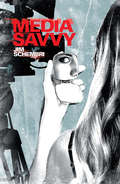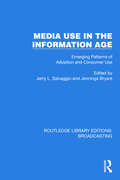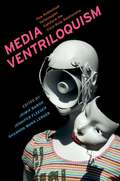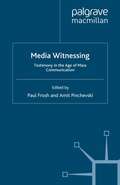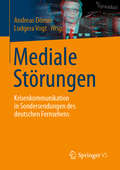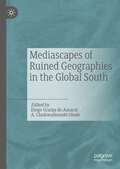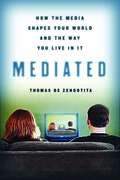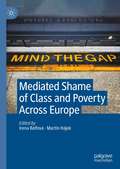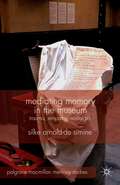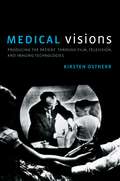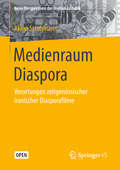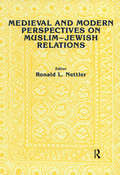- Table View
- List View
Media Savvy
by Jim SchembriWhile on work experience with a TV news crew, 16 year-old Cobey Miles suddenly finds herself in front of the camera covering a breaking news story about two bodies being uncovered in the ice. She proves an instant hit and her burgeoning modelling career starts to skyrocket. But when she sniffs something fishy behind the scenes at the station, Cobey realises that the story she has to tell is something certain people do not want to hear. Cobey is ultimately faced with a hard choice: leave the story alone and seize upon the success she is enjoying, or reveal the truth and risk consequences that may endanger her career – or her life. From the acclaimed author of MURDER IN AISLE 9, WELCOME TO MINUTE 16 and THE EIGHT LIVES OF STULLIE THE GREAT, Jim Schembri once again scripts a fast-paced and edgy novel, laced with humorous writing.
Media Studies: A Complete Introduction (Complete Introductions Ser.)
by Joanne HollowsWritten by an academic and researcher with over twenty years' experience in teaching and convening Media Studies courses, Media Studies: A Complete Introduction is designed to give you everything you need to succeed, all in one place. It covers the key areas that students are expected to be confident in, outlining the basics in clear jargon-free English, and then providing added-value features like case studies, and even lists of questions you might be asked in your seminar or exam.The book uses a structure that mirrors the way Media Studies is taught on many university courses. Chapters include essential coverage of the history, organization and production of the media industries, and regulation of the media. The analysis of media texts is covered in detail, as are the issues of identity and gender, the idea of globalization and the shifting face of social media in its many contexts.
Media Use in the Information Age: Emerging Patterns of Adoption and Consumer Use (Routledge Library Editions: Broadcasting #27)
by Jerry L. SalvaggioMedia Use in the Information Age (1989) analyses new technologies, their impact on mass communications, and their effects on the users of these new systems. It looks at technologies such as videotex, and their successes and failures around the world, and examines the early adoptions of technologies such as home computers.
Media Use in the Information Age: Emerging Patterns of Adoption and Consumer Use (Routledge Library Editions: Broadcasting #27)
Media Use in the Information Age (1989) analyses new technologies, their impact on mass communications, and their effects on the users of these new systems. It looks at technologies such as videotex, and their successes and failures around the world, and examines the early adoptions of technologies such as home computers.
Media Ventriloquism: How Audiovisual Technologies Transform the Voice-Body Relationship
The word "ventriloquism" has traditionally referred to the act of throwing one's voice into an object that appears to speak. Media Ventriloquism repurposes the term to reflect our complex vocal relationship with media technologies. The 21st century has offered an array of technological means to separate voice from body, practices which have been used for good and ill. We currently zoom about the internet, in conversations full of audio glitches, using tools that make it possible to live life at a distance. Yet at the same time, these technologies subject us to the potential for audiovisual manipulation. But this voice/body split is not new. Radio, cinema, television, video games, digital technologies, and other media have each fundamentally transformed the relationship between voice and body in myriad and often unexpected ways. This book explores some of these experiences of ventriloquism and considers the political and ethical implications of separating bodies from voices. The essays in the collection, which represent a variety of academic disciplines, demonstrate not only how particular bodies and voices have been (mis)represented through media ventriloquism, but also how marginalized groups - racialized, gendered, and queered, among them - have used media ventriloquism to claim their agency and power.
Media Witnessing: Testimony in the Age of Mass Communication
by P. Frosh A. PinchevskiFrom the Holocaust to 9/11, modern communications systems have incessantly exposed us to reports of distant and horrifying events, experienced by strangers, and brought to us through media technologies. In this book leading scholars explore key questions concerning the truth status and broader implications of 'media witnessing'.
Mediale Dispositive (Neue Perspektiven der Medienästhetik)
by Ivo Ritzer Peter W. SchulzeDer Band nimmt zum einen in einer Doppelperspektive die distinkten Genre-Rekurse der jeweiligen Einzelmedien in den Blick wie zum anderen auch die transmediale Zirkulation von Genre-Parametern. Dementsprechend beschäftigen sich die Beiträge sowohl mit den für spezifische Medien charakteristischen Genre-Diskursen als insbesondere auch mit den medienübergreifenden Adaptionsprozessen von Genres in unterschiedlichen medialen Kontexten.
Mediale Landschaftskonstruktionen: Die Darstellung des (sub)urbanen Lebens am Beispiel US-amerikanischer Serien (RaumFragen: Stadt – Region – Landschaft)
by Julia KlumpeIn diesem Buch erfolgen aus sozialkonstruktivistischer Perspektive eine qualitative Repräsentationsanalyse sowie eine quantitative Rezeptionsanalyse der drei US-amerikanischen Serien Gilmore Girls, Desperate Housewives und How I Met Your Mother. Die Autorin untersucht zum einen, welchen Einfluss die in den Serien gezeigten Landschaften auf die Wahrnehmung US-amerikanischer Landschaften durch die Rezipient*innen haben und stellt zum anderen heraus, inwieweit durch die dargestellten Landschaften Idealbilder konstruiert werden. Im Zentrum der Rezeptionsanalyse steht die Korpusanalyse entsprechender Fan-Foren. Untersucht wird, wie filmische Texte, insbesondere filmische Landschaften, in populäre Diskurse eingebettet werden.
Mediale Störungen: Krisenkommunikation in Sondersendungen des deutschen Fernsehens
Sondersendungen des öffentlich-rechtlichen Fernsehens sind eine zentrale Institution der politischen Medienöffentlichkeit in Deutschland. Sie werden unter hohem Zeitdruck und mit Aufbietung geballter journalistischer Kompetenz produziert. Die Medienakteure sehen sie voller Stolz als imagebildende ‚Premiumprodukte‘ an. Für das Publikum markieren die Formate relevante Störungen gesellschaftlicher Normalität. Sie bieten zudem Einordnungen, Lösungsperspektiven sowie Vergemeinschaftung und Trost. Für politische Akteure sind die Sendungen eine relevante Bühne politischer Krisenkommunikation.
Mediale Topographien: Beiträge zur Medienkulturgeographie
by Marcus Stiglegger Anton EscherFilmwissenschaftliche Analyse und die Methodik der Kulturgeographie werden in diesem neuartig perspektivierten Band zusammengeführt, um die medialen Topographien und Raumentwürfe des narrativen Films zu erkunden. Neben definitorischen Kapiteln zu Grundbegriffen der Filmgeographie finden sich Reflexionen zu den mythischen Räumen des Films, zur medialen Konstruktion ikonischer Orte (Casablanca, Tanger) sowie über die filmische Adaption von Grenz-Räumen und Konflikten (USA/Mexiko).
Medialität der Mise-en-scène: Zur Archäologie telekinematischer Räume (Neue Perspektiven der Medienästhetik)
by Ivo RitzerMit dem Konzept der Mise-en-scène definiert der Band die Medialität telekinemati-scher Medien neu. Dabei arbeitet die Studie telekinematische Inszenierungsprakti-ken und ihre Subjekteffekte ebenso heraus wie sie die Frage beantwortet, warum und auf welche Weise diese Formen der Mise-en-scène historisch manifest geworden sind. Im Versuch einer Synthese von Medientheorie und ästhetischer Theorie zu medienästhetischer Theorie werden differente Möglichkeiten aufgezeigt, dem multidimensionalen Konzept der Mise-en-scène gerecht zu werden und ihrem diskursiv-poetologischen Reichtum zwischen technologischem Apriori und ästhetischen Potentialen zu entsprechen.
Mediascapes of Ruined Geographies in the Global South
by Diego Granja do Amaral A. Chukwudumebi ObuteThis book undertakes an interdisciplinary and cross-cultural interrogation of the Global South through the prisms of media and cultural studies. It closely explores the quotidian (re)territorialization, and brazen ruination of the material geographies of this vast expanse of the world by forces and proxies of (neo)colonialism and global capitalism of resource extraction. We cite the ongoing expulsion of Palestinians from their homelands by occupational forces, the emerging detritus dump across Mexico City and Lagos, the infrastructural precariousness of the favelas of Brazil, the unending resource-war in the Democratic Republic of Congo (DRC), and the flagrant operation of the oil industry in the Niger Delta region of Nigeria as examples of this geographic cataclysm. The centripetal forces of neo-colonialism and resource extraction at full-flight in the Global South, aided by toxic hegemonic forces, have overtly tossed some of the population to the peripheries of existence and the society at large. As such, this book, additionally, explores the resistance of the subalterns from the margins to this socio-political malaise, and further unmasks the knowledge production from these margins of the Global South. This project is divided into five (5) parts of three essays each. The first part examines the territorial contestation in the Middle East framed and expressed through films and literary lenses. The second part examines the environmental burden of modern consumerism and urbanization on metropolis across Mexico, Brazil, and Nigeria, while the third part explores the attritional violence of resource extraction in the DRC, Brazil, and Nigeria via filmic and journalistic lenses. The fourth part offers a swift response from the margins through ethnographic and journalistic interrogation of the subjectivity of the subalterns of Brazilian favelas, and street artists. The fifth part offers an engaging critique of the political climates of South Africa and Brazil that reinforce the environmental catastrophe of the regions of the world.
Mediated: How the Media Shapes Your World and the Way You Live in It
by Thomas De ZengotitaIn this utterly original look at our modern "culture of performance," de Zengotita shows how media are creating self-reflective environments, custom made for each of us. From Princess Diana's funeral to the prospect of mass terror, from oral sex in the Oval Office to cowboy politics in distant lands, from high school cliques to marital therapy, from blogs to reality TV to the Weather Channel, Mediated takes us on an original and astonishing tour of every department of our media-saturated society. The implications are personal and far-reaching at the same time. Thomas de Zengotita is a contributing editor at Harper's Magazine and holds a Ph.D. in anthropology from Columbia University. He teaches at the Dalton School and at the Draper Graduate Program at New York University. "Reading Thomas de Zengotita's Mediated is like spending time with a wild, wired friend-the kind who keeps you up late and lures you outside of your comfort zone with a speed rap full of brilliant notions."-O magazine "A fine roar of a lecture about how the American mind is shaped by (too much) media...."-Washington Post "Deceptively colloquial, intellectually dense...This provocative, extreme and compelling work is a must-read for philosophers of every stripe."-Publishers Weekly
The mediated Arctic: Poetics and politics of contemporary circumpolar geographies
by Johannes RiquetThe mediated Arctic analyses the multiple relations between geography and cultural production that have long shaped – and are currently transforming – the circumpolar world. It explores how twenty-first-century cultural practitioners imagine and poeticise various elements of Arctic geography, and in doing so negotiate pressing environmental, (geo)political, and social concerns. From the plasmatic force of ice in Disney’s Frozen films to the spatial vocabulary of circumpolar Indigenous hip hop, it addresses Arctic geographical imaginaries in a wide range of media, including literature, cinema, comic books, music videos, and cartographic art. The book brings together a plurality of voices from within and outside the circumpolar North, both in terms of the works analysed and in its own collaborative scholarly practice. The book bridges Indigenous and Southern mediations of the Arctic and combines different epistemologies to do justice to these imaginaries in their diversity.
Mediated Shame of Class and Poverty Across Europe
by Irena Reifová Martin HájekThe key concepts of the book are media, class, poverty, and shaming. The contributors to this book examine how certain social relations and their cultural meanings in the media, namely class and poverty, are transformed into factual or moral attributes of people and situations. Class and poverty are not understood as certain things and actions, or concepts and numbers; both class and poverty are assumed to be, above all, particular social relationships or a set of relations between people, things and symbols. Without denying that contempt for the destitute Other is an affect found throughout history and in various socioeconomic contexts, the chapters in this book – through their concern with the mediated gaze on class – narrate predominantly the challenges brought about by the media’s spectacular take on poverty and low status as they (at least) coincide with the neoliberal era. This volume will be essential reading for the scholars specialising in the study of media and social inequalities form the vantage points of Media Studies, Sociology, Anthropology or European Studies.
Mediating Memory in the Museum: Trauma, Empathy, Nostalgia (Palgrave Macmillan Memory Studies)
by S. Arnold-de-Simine Silke Arnold-de SimineMediating Memory in the Museum is a contribution to an emerging field of research that is situated at the interface between memory studies and museum studies. It highlights the role of museums in the proliferation of the so-called memory boom as well as the influence of memory discourses on international trends in museum cultures.
Mediations of Disruption in Post-Conflict Cinema
by Adriana Martins Alexandra Lopes Mónica DiasMediations of Disruption in Post-Conflict Cinema is a transdisciplinary volume that addresses the cinematic mediation of a wide range of conflicts. From World War II and its aftermath to the exploration of colonial and post-colonial experiences and more recent forms of terrorism, it debates the possibilities, constraints and efficacy of the discursive practices this mediation entails. Despite its variety and amplitude in scope and width, the innovative and singular aspect of the book lies in the fact that the essays give voice to a variety of regions, issues, and filmmaking processes that tend either to remain on the outskirts of the publishing world and/or to be granted only partial visibility in volumes of regional cinema.
Medical Visions: Producing the Patient Through Film, Television, and Imaging Technologies
by Kirsten OstherrHow do visual images shape the practice of medicine? What role does visual representation play in the cultivation of medical ways of seeing? And how has medicine's visual culture changed in the digital age? Kirsten Ostherr's ambitious study explores 120 years of medical image-making to explain how visual representations shape medical education and practice. Marshaling powerful, vivid examples she demonstrates how medical images created by the healthcare industry, documentary filmmakers, experimental artists, and the mass media acquire cultural meaning and influence doctors' and patients' understandings of health and disease. Her analysis proceeds chronologically, turning from the earliest experiments with medical filmmaking by the American College of Surgeons, to the place of health films in the "golden age" of instructional film in the 1960s. Ostherr considers the shift to television as the dominant medium of health education, highlighting the evolving status of realism, the techniques employed to bridge the entertainment-education divide, the role of expert consultants and sponsors, and the tradeoffs made by professionals to reach a broad audience. The rise of physician advice segments on newsmagazines forms a transition between medical dramas like Marcus Welby, MD and more recent reality shows like Boston Med and Doctor 90210. Concluding with a section on advertising and social media in the health care setting, the book ends with ten key lessons for the future of medical media.
Medical Visions: Producing the Patient Through Film, Television, and Imaging Technologies
by Kirsten OstherrHow do visual images shape the practice of medicine? What role does visual representation play in the cultivation of medical ways of seeing? And how has medicine's visual culture changed in the digital age? Kirsten Ostherr's ambitious study explores 120 years of medical image-making to explain how visual representations shape medical education and practice. Marshaling powerful, vivid examples she demonstrates how medical images created by the healthcare industry, documentary filmmakers, experimental artists, and the mass media acquire cultural meaning and influence doctors' and patients' understandings of health and disease. Her analysis proceeds chronologically, turning from the earliest experiments with medical filmmaking by the American College of Surgeons, to the place of health films in the "golden age" of instructional film in the 1960s. Ostherr considers the shift to television as the dominant medium of health education, highlighting the evolving status of realism, the techniques employed to bridge the entertainment-education divide, the role of expert consultants and sponsors, and the tradeoffs made by professionals to reach a broad audience. The rise of physician advice segments on newsmagazines forms a transition between medical dramas like Marcus Welby, MD and more recent reality shows like Boston Med and Doctor 90210. Concluding with a section on advertising and social media in the health care setting, the book ends with ten key lessons for the future of medical media.
Medical Visualization and Applications of Technology ‒ Volume 2 (Biomedical Visualization #5)
by Jenny Clancy Matthieu PoyadeThis edited volume encompasses chapters on novel and innovative research in the applications of leading digital technologies in an accessible and engaging way. By utilising cutting edge and ever progressive technology in visualization, it will enhance our understanding and application in our everyday lives. This volume shows how we can use Extended Reality, 3D animations and serious games to benefit the learner, educator, clinician, patient, parent and carer. Visualization techniques like Virtual, Augmented and Mixed Reality and show how they can be utilised to improve training and understanding of anatomy, surgery, and clinical assessment. This is covered specifically for emergency practitioners in enhancing their understanding of ECG’s for potential myocardial infarction by using augmented reality. From a translational medicine perspective and pre-operative pediatric surgical planning, the benefits of augmented reality are examined as to what might be found intra-operatively from imaging techniques. Educational applications of digital technologies using serious games and Extended Reality are examined. We show how Mixed Reality can aid understanding in cellular anatomy for our learners and researchers alike. We also show how serious games can have applications in diverse areas like parasite infections and neuroanatomy education and training. Finally, from a clinical perspective, the use of 3D animations and their applications is discussed for vertebral fractures and increasing parent/carer awareness through interactive applications. Also, the use of 3D animations in cerebral magnetic resonance angiography for global education highlights the great benefits of these tools and technologies. There is something for the researcher, clinician, educator, patient, and carer as we explore novel technologies. These are applied locally, nationally and globally as we advance our understanding of the world changing influence that digital technologies have on our day-to-day life.
Medienkulturen des Dokumentarischen (Film und Bewegtbild in Kultur und Gesellschaft)
by Carsten Heinze Thomas WeberDer Band analysiert dokumentarische Formen des Films, die in aktuellen Medienkulturen eine zunehmend wichtigere Rolle spielen und für die Kommunikation in modernen Gesellschaften maßgeblich verantwortlich sind. Durch neue Technologien und veränderte Formen der Produktion, Distribution und Rezeption sowie innovative ästhetische Konzepte kommt es zu einer Ausdifferenzierung der dokumentarischen Praktiken in ihren jeweiligen Medienkulturen, die nicht zuletzt auch das Verständnis dessen verändern, was unter dokumentarischen Filmen jeweils zu verstehen ist. Diese Entwicklungen werfen Fragen auf, auf die Autorinnen und Autoren aus der Medien- und Kulturwissenschaft, der Geschichtswissenschaft, der Kunstwissenschaft und der Soziologie in diesem Band Antworten geben.
Medienraum Diaspora: Verortungen zeitgenössischer iranischer Diasporafilme (Neue Perspektiven der Medienästhetik)
by Alena StrohmaierAlena Strohmaier diskutiert in diesem Open-Access-Buch die komplexen Konfigurationen von Diaspora, deren soziopolitische und kulturelle Aspekte und unternimmt eine theoretische Dimensionierung des Begriffs, indem sie diesen als sowohl räumliche als auch filmische Kategorie versteht. Als Bindeglied zwischen den beiden Theorietraditionen dient ihr dabei die Kategorie des Raums, die als ästhetische Kategorie gleichermaßen konstitutiv für filmische Artefakte ist, wie sie es als sozialgeografische für die Diaspora ist. Die Autorin zeigt am Beispiel des zeitgenössischen iranischen Diasporafilms, wie die Theorie des Films mit dem Konzept der Diaspora jenseits essentialistischer Vorstellungen von ethnischen, kulturellen oder religiösen Zugehörigkeiten zusammenzudenken ist.
Medieval and Early Modern Film and Media
by R. BurtMedieval and Early Modern Film and Media contextualizes historical films in an innovative way - not only relating them to the history of cinema, but also to premodern and early modern media. This philological approach to the (pre)history of cinema engages both old media such as scrolls, illuminated manuscripts, the Bayeux Tapestry, and new digital media such as DVDs, HD DVDs, and computers. Burt examines the uncanny repetitions that now fragment films into successively released alternate cuts and extras (footnote tracks, audiocommentaries, and documentaries) that (re)structure and reframe historical films, thereby presenting new challenges to historicist criticism and film theory. With a double focus on recursive narrative frames and the cinematic paratexts of medieval and early modern film, this book calls our attention to strange, sometimes opaque phenomena in film and literary theory that have previously gone unrecognized.
Medieval and Modern Perspectives
by NettlerFirst Published in 1995. Routledge is an imprint of Taylor & Francis, an informa company.
Medieval and Modern Perspectives
by NettlerFirst Published in 1995. Routledge is an imprint of Taylor & Francis, an informa company.
